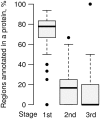LAMPA, LArge Multidomain Protein Annotator, and its application to RNA virus polyproteins
- PMID: 32003788
- PMCID: PMC7203729
- DOI: 10.1093/bioinformatics/btaa065
LAMPA, LArge Multidomain Protein Annotator, and its application to RNA virus polyproteins
Abstract
Motivation: To facilitate accurate estimation of statistical significance of sequence similarity in profile-profile searches, queries should ideally correspond to protein domains. For multidomain proteins, using domains as queries depends on delineation of domain borders, which may be unknown. Thus, proteins are commonly used as queries that complicate establishing homology for similarities close to cutoff levels of statistical significance.
Results: In this article, we describe an iterative approach, called LAMPA, LArge Multidomain Protein Annotator, that resolves the above conundrum by gradual expansion of hit coverage of multidomain proteins through re-evaluating statistical significance of hit similarity using ever smaller queries defined at each iteration. LAMPA employs TMHMM and HHsearch for recognition of transmembrane regions and homology, respectively. We used Pfam database for annotating 2985 multidomain proteins (polyproteins) composed of >1000 amino acid residues, which dominate proteomes of RNA viruses. Under strict cutoffs, LAMPA outperformed HHsearch-mediated runs using intact polyproteins as queries by three measures: number of and coverage by identified homologous regions, and number of hit Pfam profiles. Compared to HHsearch, LAMPA identified 507 extra homologous regions in 14.4% of polyproteins. This Pfam-based annotation of RNA virus polyproteins by LAMPA was also superior to RefSeq expert annotation by two measures, region number and annotated length, for 69.3% of RNA virus polyprotein entries. We rationalized the obtained results based on dependencies of HHsearch hit statistical significance for local alignment similarity score from lengths and diversities of query-target pairs in computational experiments.
Availability and implementation: LAMPA 1.0.0 R package is placed at github (https://github.com/Gorbalenya-Lab/LAMPA).
Supplementary information: Supplementary data are available at Bioinformatics online.
© The Author(s) 2020. Published by Oxford University Press.
Figures








References
-
- Charif D., Lobry J.R., (2007) SeqinR 1.0-2: a contributed package to the R project for statistical computing devoted to biological sequences retrieval and analysis In: Bastolla Uet al. (eds.) Structural Approaches to Sequence Evolution: Molecules, Networks, Populations. Springer Berlin Heidelberg, Berlin, Heidelberg, pp. 207–232.
-
- Das K., Arnold E. (2015) Negative-strand RNA virus L proteins: one machine, many activities. Cell, 162, 239–241. - PubMed
Publication types
MeSH terms
Substances
LinkOut - more resources
Full Text Sources
Miscellaneous

